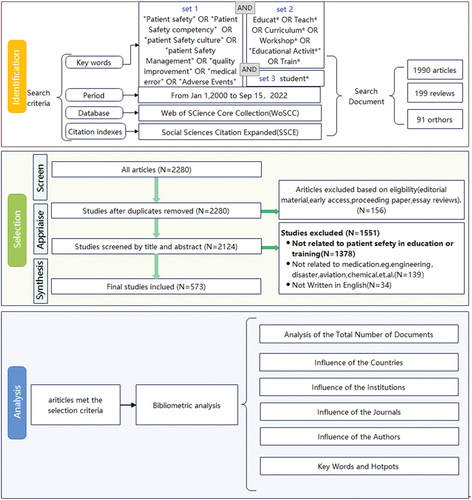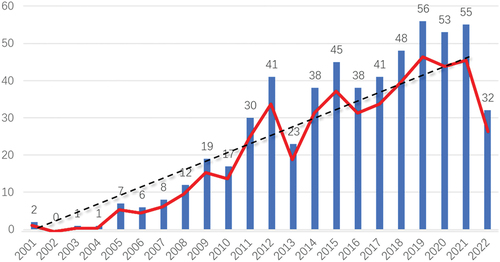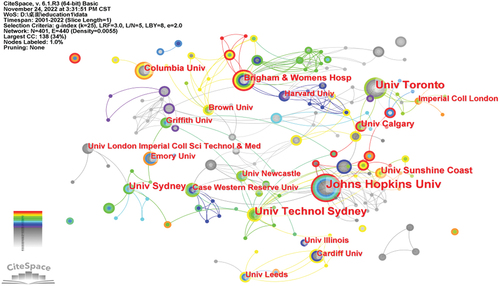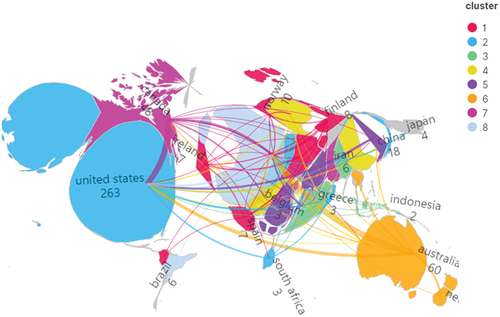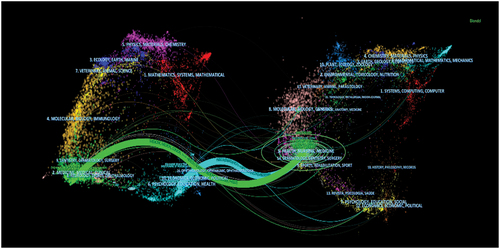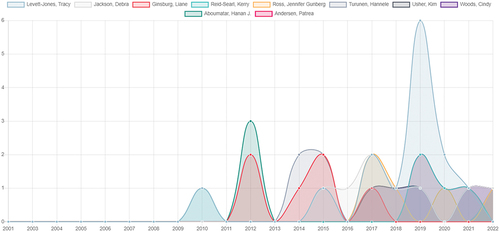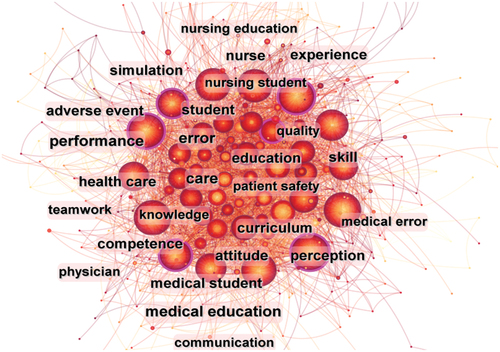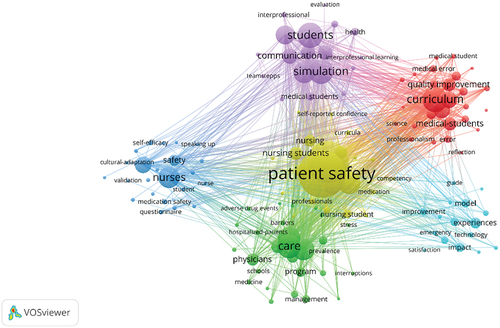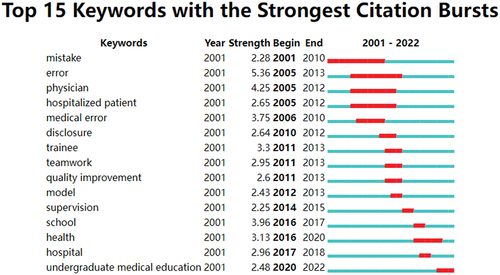 ?Mathematical formulae have been encoded as MathML and are displayed in this HTML version using MathJax in order to improve their display. Uncheck the box to turn MathJax off. This feature requires Javascript. Click on a formula to zoom.
?Mathematical formulae have been encoded as MathML and are displayed in this HTML version using MathJax in order to improve their display. Uncheck the box to turn MathJax off. This feature requires Javascript. Click on a formula to zoom.ABSTRACT
Research and practice in patient safety education have garnered widespread attention; however, a comprehensive bibliometric analysis is lacking. This study aimed to provide a comprehensive understanding of the research focus and research trends in the globalization of the field of patient safety education and to describe the general characteristics of publications. Data on articles and reviews about student safety education were extracted from Web of Science. Microsoft Excel 2019, CiteSpace 6.1.R3, VOSviewer 1.6.18, SATI 3.2, Scimago Graphica, and Pajek were used for quantitative analysis. Collaboration networks of countries, institutions, journals, authors, and keywords were visualized based on publications from January 2000 to September 2022. A total of 573 papers were published between 2000 to 2022, showing an overall increasing trend. The USA, England, and Australia are the top three most prolific countries; Johns Hopkins University, the University of Technology Sydney, and the University of Toronto are the top three most productive institutions; Nurse Education Today, Journal of Nursing Education, and BMC Medical Education are the most productive journals; Based on content analysis five research hotspots focused on: (1) Quality Improvement of Patient safety Teaching and Learning; (2) Patient safety Teaching Content; (3)Specialized Teaching in Patient Safety; (4) Integrating Patient Safety and Clinical Teaching; (5)Patient Safety Teaching Assessment Content. Through keyword clustering analysis, five research hotspots and relevant contents were identified. According to this study, simulation, communication, collaboration, and medication may attract more attention from researchers and educators, and could be the major trend for future study.
Introduction
Patient safety (PS) is an important issue in global public health [Citation1]. It is estimated that up to 80% of all injuries are preventable, with errors related to diagnosis, prescribing, and medication administration being the most harmful [Citation2]. Stefan Lindgren (President of the World Federation for Medical Education) stated, ‘Patient safety is a core attitude that needs to be introduced as early as possible and then reinforced during postgraduate education and continuing professional development’. WHO developed the WHO Patient Safety Curriculum Guide: Multi-Professional Edition, presenting the general requirements for incorporating PS in education. The guide is pertinent in the context of global educational reforms and growing recognition of the need to introduce patient safety into healthcare professionals’ curricula. As healthcare systems’ complexity increases and PS incidents’ hazards increase, the need for effective patient safety education (PSE) for healthcare professional students becomes paramount. As a system property, patient safety education and training has a key role in achieving the goal of harm minimization. A more fundamental change is required within healthcare curriculum, clearly acknowledging the importance of creating a patient safety culture at the beginning of training. Medical students’ future healthcare professionals, their PS knowledge, skills, and attitudes (KSA) acquired in school would affect their capacities to cope with patient safety issues, thereby affecting patients’ health outcomes [Citation3]. By prioritizing PS during a student’s education, a strong foundation can be built to address these issues in their future practice.
Beginning in the 1990s, scholars began to research, among other things, how educating medical students can provide safer care. PSE’s research in this area has gained increasing international attention and demonstrated multiple benefits. For example, research shows that teaching patient safety can have a positive impact by promoting the competencies needed for safe health care(S. E [Citation4]; [Citation5]. This is similar to the Mansour et al. study, PSE not only improves students’ KSAs related to patient safety [Citation6] but also prepares them for a smooth transition into clinical practice. Furthermore, with improved theoretical knowledge and intervention skills, students can actively contribute to PS initiatives and minimize their own risk of becoming secondary victims of medical errors [Citation7]. Instilling a culture of PS during a student’s education sets the stage for continuing that culture throughout their clinical training and career [Citation8–11]. PSE for medical students facilitates patient outcomes, improves safety culture and teamwork climate, and enhances patient safety and quality of healthcare.
The development of multiple pedagogical approaches and interprofessional collaboration across an increasing number of subject areas has resulted in a large body of research from various perspectives that have significantly contributed to the study of PSE. While the literature in the field is gradually expanding, the increasing number of publications makes it difficult to get a comprehensive picture of the literature on patient safety education. When patient safety education is searched in the database along with concepts such as intervention and assessment, studies such as content interventions such as human factors and safety leadership [Citation12–14], the application of different teaching methods [Citation15,Citation16], and course instruction at different levels in different specialties [Citation17–20], etc), among others can be seen. Although medical student education constantly evolve overtime, and different patient safety value different from institution to institution, education and training has always remained the priority. In addition, advances in patient safety and quality improvement have facilitated by the creation of specialized studies to improve recommendations in patient safety, as well as a growing number of studies on patient safety education. However, although administrators and educational researchers now have quick access to patient safety education papers, patient safety education still lacks a systematic approach and conducted in different ways, and is a need for a systematic, interdisciplinary review and synthesis to help researchers gain a comprehensive understanding of PSE in an international perspective comprehensive summaries of PSE are available to quickly identify the prevailing trends in research on the core competencies [Citation21]. This analysis helps to explore a roadmap for the field to understand where it is and where it might headed in the future, and to inform the literature for educational and managerial decision-making.
Bibliometrics refers to the cross-cutting science of quantitatively analyzing all knowledge carriers using mathematical and statistical methods, integrating mathematics, statistics, and bibliography, focusing on the assessment of publication and citation data, such as the impact, productivity, and trends of a particular field or topic, and focusing on a quantitative and comprehensive body of knowledge. It formed an independent discipline in 1969 [Citation22] and became widely applied in literature analysis [Citation23]. Details such as authors, keywords, journals, countries, institutions, and references can be captured in the analysis process and generate an integrative view and quantitative parameter profiling of entire research fields or specific scientific application areas [Citation24]. Modern computer technology can generate graphical and visual results, which can complement traditional literature analysis. With the help of modern computer technology, graphical and visual results can supplement literature analysis Co-citation is also frequently used in the bibliometric analysis. It has been emphasized by Ma and Xi [Citation25] that visualized co-citation analysis in bibliometrics, could facilitate data interpretation; it can make results more comprehensive and contribute to the development of the field [Citation26]. The visualization helps excavate the internal relationship of this information, such as having the same research topic from different authors, the research focus of different institutions, new theories coming from an existing one and so on. Previous work has focused on specific areas of PSE, such as El-Awaisi et al. [Citation27] targeted the content, delivery, and outcomes of patient safety reviewed PS in pharmaceutical education and highlighted the positive impact of PSE in this field. Mugerwa et al. [Citation28] conducted a systematic and comprehensive scoping review of undergraduate nursing students over the last 10 years, but the study was only protocol. All of these reviews focused on a particular specialty or discipline and lacked a comprehensive, integrated overview [Citation29–31], and in light of the previous considerations, a bibliometric and content analysis was conducted to scan recent studies with the aim of:
Identifying and describing the research institutions, countries, journals, and authors in the field of patient safety research that are most relevant to healthcare professional education;
determining and describing the thematic structure of the field of patient safety research in the context of healthcare professional education and
Describe and analyze the thematic content of the patient safety research field in terms of healthcare professional education
Materials and methods
Data acquisition and search strategy
Web of Science (core collection) was selected as the data source for this study, as it has been widely accepted as a high-quality digital literature resource database covering a wide range of publications in different fields and is considered the best data source for bibliometric analysis [Citation32,Citation33]. The unique citation index allows us to understand the evolution of research content and directions without being limited by keyword variations. We developed a search strategy by reading previously identified relevant literature searches to discover publications mentioning these words and their derivatives in the title, abstract or keywords. We continuously optimized them during the search process. The search terms were as follows: TS=(‘Patient safety’ OR ‘Patient Safety competency’ OR ‘patient Safety culture’ OR ‘patient Safety Management’ OR ‘quality improvement’ OR ‘medical error’ OR ‘Adverse Events’) AND TS=(Educat* OR Teach* OR Curriculum* OR Workshop* OR ‘Educational Activit*’ OR Train*) AND TS=(student*). Yinsong Sun and Jun Luo independently searched and the identification part. The search strategy is described in supplementary materials .
Table 1. The top 10 institutions on PS in education.
Inclusion and exclusion criteria
Only articles and reviews were searched to reduce errors caused by differences in the format in which data were presented, and the language was limited to English. Therefore, to eliminate errors further, according to the database’s screening function, articles in non-life science fields in the ‘research direction’ category, such as economics, engineering, and agronomy, were manually removed. After an initial search, we limited the inclusion criteria to the published date range from January 2000 to 15 September 2022. 2000 was chosen because the landmark report, To Err is Human, created a furor in the medical community and was followed by the development of evidence-based practices in the late 1990s. Read titles and abstracts to exclude publications unrelated to patient safety, medicine, etc. Raw data sets were exported from WoS in a ‘plain text’ file format and WoS tag lists were added, including DOI, authors, title, publication year and month, journal, author contact information, abstract, and references. shows the bibliometric selection flow chart and framework. Finally, the cleaned data were imported into the software for internal structural analysis. The final result was 573 valid publications (515 articles and 58 review articles). Lu Zhou and Jun Wang completed the selection part and extracted the data independently. In the event of a dispute, a third researcher was consulted.
Analysis tool and data analysis
The following software was used in this study: a. Microsoft Office Excel, the function of a line chart or bar chart that can easily and intuitively see the long-term and annual trends of data from the data change trend, were analyzed publication trends and aggregated subject terms; b. Statistical Analysis Tool Toolkit for Informetrics 3.2 (SATI) [Citation34], provides a wonderful picture of the number of publications published each year by readers, organizations, authors, etc, used to analyze influential authors, institutions, and publications. c. CiteSpace 6.1.R3(C [Citation35], The advantage is that the hot spot can be detected, and the change of the research hot spot in time can be interpreted through the timeline, which was used to identify emerging topics and centrality by depicting dual-map overlays of journals and detecting keywords with strong burst strength over time [Citation36–39]. However, CiteSpace has drawbacks, including node overlap, complexity, and high data requirements. d. In contrast, VOSviewer uses a distance-based visualization method to draw maps by defining the relative positions between texts. This method can present knowledge maps and visualize non-overlapping distance-based maps and clustering with minimal overlap. However, it has simple functionality and cannot display field evolution over time [Citation40,Citation41]. e. Therefore, Pajek [Citation42], (http://vlado.fmf.uni-lj.si/pub/networks/pajek/) in November 1996 by Boolean, the university’s Wooladimir Batagli (V. Batagelj and Andre A. Marvar Mrvar), developed in the Adelphi (Pascal) language, is A network analysis and visualization program specifically designed to process large data sets and generate a series of intersected networks, was used to adjust VOSviewer maps for co-author and keyword analysis, clustering with colors to visualize PSE frontiers. f. Finally, Scimago Graphica was used to create a collaboration network between countries/regions and institutions and generate a geographic visualization map, mapped the global distribution of national publications.
Results
The evolution in the total number of publications, influence, keywords, and other elements directly reflects the changing research enthusiasm in the PSE field over the past 20 years. These metrics also serve as important indicators to measure the developmental trends in this emerging area during this period.
Analysis of the total number of documents
The annual publications are shown in . The annual publications on PSE for students increased from 2 in 2001 to 55 in 2021. The number of documents published annually reveals three distinct stages in this research area (Phase I: 2001–2007; Phase II: 2008–2016; Phase III: 2017–2021). From 2001–2007, there were fewer than 10 publications per year. From 2008-to 2016, publication numbers fluctuated with two peaks(2012, 2015), and several significant references emerged [Citation43]. From 2017–2021, over 30 papers were published annually, representing over half of total publications in just the past five years.
Institutions in the field of patient safety research most relevant to healthcare professional education
In Citespace, (i) choosing selection criteria ‘By Degree’ and setting the parameter threshold value = 5, and (ii) choosing selection criteria ‘By Citation’ and setting the parameter threshold value = 10 (nodes are 401, links are 440, in ). Johns Hopkins University, University of Technology Sydney, and University of Toronto were the top producers, as shown in , with institutions with high mediational centrality. Betweenness centrality measures a node’s network location – values above 0.1 signify critical nodes. Nodes with high betweenness centrality often connect distinct fields as key hubs, wielding substantial influence in co-occurrence networks. Figure S1 shows only the top 10 institutions publishing papers over 20 years, with the vertical axis indicating the number of documents.
Countries in the field of patient safety research most relevant to healthcare professional education
After inputting the data into Vosviewer and converting it to GML format, import it into Scimago and set the fields: area size as country colour as clusters. The results show that scholars from 56 countries have published on PSE, and the countries and partnerships are shown in the geographic map and Chord charts Figure S2. The United States led the research output with 263 documents, followed by England (n = 68) and Australia (n = 60). Data Putin citespace, select the selection criteria ‘by degree’ and set the parameter threshold = 10; select the selection criteria ‘by citation’ and set the parameter threshold = 6 (nodes are 65, links are 250). More intuitively, the top 10 countries can be seen in , where the top five countries accounted for 74.14% of total publications,
Table 2. The top 10 countries/regions on patient safety in education.
Journals in the field of patient safety research most relevant to healthcare professional education
In VOSviewer, co-citation analysis was performed: (i) Analysis type was set to ‘co-citation’ and unit to ‘cited source’ and (ii) Minimum citations per source was set to 1. (137 journals have published 573 articles on PSE). displayed the top 10 active and co-cited journals, and Figure S3 displayed the yearly trend in publications, with Nursing Education Today published the most publications (53 total, 1112 citations), followed by the Journal Of Nursing Education (48 publications). BMC Medical Education (36 publications). To further examine the publication status, Bradford’s Law [Citation44] was applied by dividing the 573 publications into three regions based on journal rankings. publication counts were similar across regions, with a journal ratio approximating 1:n:n2. The ratio of journals across the regions was 7:21:108 ≈ 1:3:9, yielding an n value of approximately 3, consistent with Bradford’s observation. Specifically, journals were classified into core, related, and unrelated regions at a ratio close to 1:n:n2 = 1:3:9. Given this ratio, the top 7 journals by publication count can be identified as representing the core region for this study and divided open access publications from 2000–2022 were divided into three regions, as shown in – ‘core’ (19+ articles), ‘relevant’ (6–18 articles), and ‘fringe’ (1–5 articles).
Table 3. Top 10 prolific journals and co-cited journals on PS in education.
Table 4. Bradford’s Law distribution of PS in education’s journals.
CiteSpace’s dual-map overlay clustered and overlaid cited journals to display disciplinary distribution, shifting gravity, and other insights. Enter JCR Journal maps from overlay maps, and overlay layers on the base map by adding overlay to obtain double images of the journal, as shown in shows, cited dentistry, medicine, and economics journals clustered prominently, along with neurology, psychology, ophthalmology, and more. Citing journals clustered primarily in health, nursing, medicine, dermatology, economics, and psychology.
Authors in the field of patient safety research most relevant to healthcare professional education
The authors were analyzed using Vosviewer with the threshold set at one publication. The results showed 2,369 authors have been published in the PSE field, as shown in Table S2. The data was inputted into SATI, with the findings presented in (only the top 10 are shown).T. Levett-Jones led with 11 publications, primarily in the Journal of Clinical Simulation in Nursing. The second most published author was Debra Jackson, a frequent collaborator of Levett-Jones, who also studied teaching design.
Price’s formula was applied:
Where n(x) represents the number of authors who have written x publications, I= is the number of publications by the most productive authors in the field (
= 14), N is the total number of authors (N = 2369), and m is the minimum number of publications by core authors. The minimum core author threshold was m = 0.749×
≈2.80. Therefore, authors with ≥ 3 publications are designated as core. Setting the threshold to 3 publications in Vosviewer showed 52 core authors with 201 publications, as shown in Figure S2, comprising 35.1% of the total. Per Price’s Law, half the papers should come from approximately the square root of the total authors [Citation45]. The results did not meet Price’s 50% benchmark, suggesting the field lacks a stable core. The network density plot in shows the collaboration of authors with more than 3 publications, and the main research teams in the field of radiotherapy localization are currently Levett-Jones, Tracy Team, L. Ginsburg, Liane Team, Ross, Jennifer Gunberg Team and Bhudla, Roshr Team, all with more than 3 publications.
Key words and hotpots
Keywords also reveal hot topics in PSE research, while Zipf’s law validated the distribution of topical keywords. CiteSpace’s ‘By Degree’ threshold was set to 15 and ‘By Cluster’ to 2, generating a keyword co-occurrence map with 466 nodes, 2810 lines, and a density 0.0259. The map contained 1486 keywords, as shown in . displays the top 20 high-frequency keywords meeting Zipf’s requirements. Zipf’s law analyzes keyword frequency as an indicator of research topics [Citation46], relating a word’s rank order in a text to its frequency – the product of a word’s rank (r) and frequency (f) approximates a constant (C). Figure S5 visualizes this Zipfian distribution of keywords in the study.
Table 5. Top 20 high-frequency keywords.
Keyword clustering was analyzed using CiteSpace’s Log-Likelihood Ratio (LLR) algorithm. The results showed that Figure S4’s Q value was 0.7389 (>0.3) and S value was 0.8102 (>0.7), suggesting the clustering is reasonable and credible. Additionally, to more clearly observe keyword categories, we combined VOSviewer and Pajek for visual analysis, selecting co-occurrence as the type and all keywords as the analysis unit. The threshold was set to a minimum of 5 occurrences. Following the text mining and image analysis, five major thematic categories within the field of patient safety research in healthcare professional education were identified, as shown in : (1) Quality Improvement of Patient Safety Teaching and Learning (teamwork, medical error, quality improvement, etc.); (2) Patient safety Teaching Content (communication, evaluation, interprofessional, etc.); (3)Specialized Teaching in Patient Safety (self-adaptation, self-adaptation, speak-up, interprofessional education, etc.); (4) Integrating Patient Safety and Clinical Teaching(prevalence, risk, accidental falls, etc.); (5)Patient Safety Teaching Assessment Content (model, technology, satisfaction, etc.). Details can be found in .
Table 6. Content analysis.
Mutation keyword analysis identified research frontiers over time. Mutation keywords refer to terms whose frequency undergoes abrupt shifts. As shown in , such dramatic increases in frequency for both high and low-frequency terms typically mark emerging research fronts. Mutation keyword frequencies spiked during periods of surge denoted by thick red lines.
Discussion
General features
Firstly, expanding global partnerships significantly impacts the implementation of educational interventions, thereby influencing students’ patient safety competency and establishing a cultural foundation. This finding aligns with Torkaman [Citation47] research. Limited collaboration between institutions may explain the absence of a stable core group of authors in the field. The largest author cluster comprises those affiliated with major research groups have access to cutting-edge knowledge and hot topics within the field. Additionally, As research matures, the author base may consolidate around consistently productive scholars. All of this indicates that concentrated research teams can yield more fruitful outcomes. The figures in this study (, S2) reveal an imbalanced distribution among countries, with closer collaboration observed among developed countries, similar to findings in Hou [Citation48] research. This success can be attributed to thees countries’ scientific, infrastructural, and economic advantages of these, as well as their early engagement and sensitivity to the field. However, this led to a noticeable ‘top-tier effect’ in the field of PSE, with the majority of achievements and closer collaborations concentrated in developed countries. To break this cycle, it is recommended to strengthen communication and collaboration in the field of patient safety in the future. Comprehending the impact of international research collaborations on quality of care, clinical decision-making, and the expansion of educational interventions is critical for prospective students [Citation49]. Furthermore, leaders/initiators in the field from different countries should enhance international connections mutually beneficially. International research collaboration is indispensable to advance PSE research [Citation50]. The progress of research heavily relies on the call from international organizations to promote patient safety education, raise awareness among excellent teachers and leaders about the importance of this field, and establish a global network for cooperation to facilitate equitable global participation and knowledge sharing.
Furthermore, Enthusiasm for this subject tends to wane within a few years. However, the introduction of relevant policies, guidelines, and high-quality literature has influenced the volume of research in patient safety education., similar to previous research findings. At the global level, the WHO released the WHO patient safety curriculum guide for Medical Schools in 2009, while The European Network for Patient Safety (EUNetPaS) published A General Guide for Education and Training in Patient Safety, both aiming to offer comprehensive guidance for the implementation and dissemination of knowledge in this domain. The National PSE Framework (NPSEF) in 2005 garnered the interest of the WHO in the realm of PSE [Citation51]. At that time, the Patient Safety Project (PSEP) received leadership support, identified key learning themes and implemented in the United States and Australia [Citation52]. Furthermore, at the institutional level. The United States Association of American Medical Colleges (AAMC) for integration PSE into the undergraduate curriculum, as highlighted in the publication Contemporary Issues in Medicine: Quality of Care [Citation53]. Moreover, at the institutional level, Various influential institutions, such as the Agency for Healthcare Research and Quality (AHRQ) (Quality), The National Foundation for Patient Safety (NPSF) (‘National Patient Safety Foundation,’), have advocated for nationwide PSE program (“ [Citation54]. Similar policies exist in Canada and the United Kingdom.The Johns Hopkins University School of Medicine published PSE Policy and Procedure Guidelines at the college level, contributing to their extensive research in the field. Few studies on PSE are published in top journals, potentially due to editors perceiving them as not meeting the standards or being outside the scope of the journals. This underscores the importance of conducting rigorous research in the field of PSE to enhance its recognition and impact within the academic community. The publication of policies promoting patient safety training has positively impacted research internationally and at the collegiate level. Emphasizing the importance of PSE through policies and providing support and resources for research will facilitate the development of effective practices. Continuity and quality challenges require ongoing efforts to support and promote PSE practices.
Content analysis
Quality Improvement of Patient Safety Teaching and Learning
Patient safety/quality improvement (PS/QI) is ais the most widely taught aspect in the PS field. As the ACGME places increasing emphasis on PS/QI, the number of articles related to education is expected to rise annually. Research focuses on the utilization of quality improvement tools whose effective use can prepare medical students for the challenges they will face in their future careers, which is consistent with Shah et al.’s [Citation55] findings. Such as the PDSA (plan, do, study, act) cycle, conducting root cause analysis, and creating fishbone diagrams, as well as effective and efficient medical care [Citation56]. In future teaching, the selection of appropriate frameworks should be tailored to students’ types and specialties, taking into consideration the diversity of their educational backgrounds and professional needs (for example, QSEN Framework [Citation57], Nephrology Curriculum Framework [Citation58], emergency medicine framework [Citation59], dermatology framework [Citation60], and so on.), aiming to enhance their preparedness for addressing quality improvement (QI) and patient safety (PS) challenges in their future employment or internships. Secondly related theoretical research [Citation61] were the another focus of this topic. Merely, existing theoretical studies have provided on y limited insights into this topic [Citation62], three comprehensive theoretical approaches – critical theory, social cognitive theory, and adaptive expertise theory – could be employed in the future to design effective educational strategies.
Patient Safety Teaching Content
The analysis revealed that current teaching content focuses on healthcare team communication, interprofessional collaboration, and adverse drug event learning. Previous studies by Leonard, Graham et al., and Topcu et al. [Citation63,Citation64] found that poor relationships and ineffective team communication contribute to medical errors by causing clinical errors and adverse events. As communication issues have long been known to impact patient safety, communication remains an important teaching area. Furthermore, Omura et al.‘s findings suggest that communication in interprofessional environments needs to be more effective needs to be more effective [Citation65]. It is recommended to utilize the TeamSTEPPS, a communication and teamwork program developed by Brock et al. [Citation66] in future teaching, which is widely applied internationally across educational levels [Citation67], to optimize the teaching effect of communication in cross-professional; and considering scenarios teaching methods like simulated surgeries and exacerbations by Med et al. [Citation68], to explore effective teaching models for interprofessional co-simulation of PS courses in an interprofessional setting where prevention is the main focus of the human life cycle; Or develop more teaching methods or tools that facilitate cross-professional communication, integrating communication, teamwork and professionalism, improves interprofessional integration and teaching/learning effectiveness when applying to interprofessional settings. Current content that addresses areas students could easily improve in future practice and work but lacks evidence measuring the impact of education and training on PS outcomes like adverse event rates and clinical errors. Future research could design content and long-term evaluations based on frameworks like Highly Reliable Teams (HRT) [Citation69] or Crew Crisis Resource Management (CRM) [Citation70], focusing on leadership, followership and communication development across curricula to better integrate communication training.
Specialized Teaching in Patient Safety
‘speaking up’ and cultural-adaptation are the special and mainstream contents in PSE field. Blame culture is a major safety risk in patient safety, threatening the health of patients, and affecting the work efficiency of medical staff and the mental health of students, which is consistent with the Schwappach study [Citation71]. The notion that silence could undermine patient safety culture and influence the efficacy of communication training, possibly perpetuating a culture of blame, is consistent with the studies of Schwappach et al. and Lin et al. [Citation71,Citation72]. Many studies have focused on the risk factors for speaking-up, including motivation, strategy, perceived effectiveness and so on [Citation73]. The literature also reported some strategies for eEffective methods to promote speaking up including leadership support [Citation74], simulation training [Citation65], and experiential situational learning [Citation75]. Furthermore, the question of why and how individuals should speak up remains unanswered [Citation75]. Therefore, it is recommended that future programs incorporate a comprehensive understanding of the speaking-up process, apply psychological principles to program design, and encourage exercisers and students to develop the habit of monitoring each other throughout the academic year. This approach will help to increase the impact of speaking and foster a favorable culture in future clinical settings where widespread cultural change is required.
Integrating Patient Safety and Clinical Teaching
Integrating clinical and classroom education is another mainstream direction for patient safety education. However, the gap between clinical practice and education may lead to some issues consistent with prior research. One potential reason is the high demands of transitioning from classrooms to clinical settings. However, receptiveness towards including safety and quality improvement in clinical training is growing. This adjustment carries a steep learning curve, and students lacking adaptive capabilities may be more prone to clinical errors and stress, consistent with studies by Myung et al. and Carter et al. [Citation76,Citation77]. As noted by Vosper et al. And Huang et al., around 38.4% of students may experience secondary trauma during this transition [Citation7,Citation78], which can affect communication and judgment. Therefore, better integrating clinical and classroom learning in future academic training is suggested, such as through simulation boot camps [Citation79] (e.g., tag team patient safety simulation [Citation80]) and promotion of psychological safety [Citation81]. This may facilitate a smoother transition to practice [Citation82,Citation83], and enhance students’ capabilities in clinical risk management, consistent with studies by Vosper et al. [Citation83]. New and experienced healthcare workers require risk management and leadership skills across scenarios. While risk management is a core competency, students suffer from a knowledge gap in risk management. Thus, emphasising the development of risk management and leadership skills within safety education is desirable. As clinical responsibilities evolve, this would allow for effective scenario management and informed decision-making for all healthcare professionals students.
Patient Safety Teaching Assessment Content
Teaching effectiveness mainly focuses on teaching purpose (guidelines), design (models), methods (technologies and experiences), and teacher competence and performance. Most evaluations so far have mainly focused on assessing student training satisfaction, knowledge, perceptions, skills, and performance. However, there have been fewer studies examining patient harm rates, medical error rates, and adverse event rates. It is recommended that future studies utilize a variety of quantitative and qualitative evaluation tools, such as surveys, tests, and observation records, to assess both student learning effectiveness and their impact on patient outcomes during clinical placements. Utilizing mixed methods across different levels will allow for a well-rounded understanding of training outcomes, including downstream impacts on PS and care delivery.
Patient Safety Education Catalog
Research on PSE covers encompassed nearly all domains of healthcare, among these diverse areas studied, medication safety stands out as particularly important. Medication safety has been recognized as a key global patient safety challenge. In 2017, the WHO identified it as the third global patient safety challenge. Since then, medication safety has continued to receive increased attention internationally. The WHO Global Patient Safety Action Plan 2021–2030 listed medication safety as one of its three top strategic objectives [Citation84] Furthermore, medication safety was selected as the theme for the fourth World Patient Safety Day 2022, emphasizing its importance. The elevated focus on medication safety issues is likely due to compelling factors. These include worldwide population aging trends, rising polypharmacy, and the finding that medication errors alone account for over one-third of global patient deaths, consistent with the research of Donaldson et al. [Citation85] and Astier-Peña et al. [Citation84,Citation85]. Addressing medication safety challenges demands a coordinated, preventative approach within healthcare systems. Introducing patient safety concepts earlier in medical education curricula can help prepare the next generation of practitioners. Continued efforts are warranted to mitigate risks and improve patient outcomes over the long term. While students hold positive attitudes toward patient safety (PS), they currently lack understanding of different error types, especially medication errors. Specifically, students are not adept at self-monitoring or self-reflection regarding errors which consistent with studies by Bajpai et al. and Lee et al. [Citation86]. We propose the following strategies to strengthen future teaching and research efforts: a. increasing the number of case studies on medication errors and encouraging students to reflect upon them will enhance their understanding. b. encouraging students to maintain reflection journals will help them identify their own shortcomings and refine their approach. c. Incorporate standard hospital medication safety programs such as adverse event reporting mechanisms into curricula. This can strengthen students’ identification with medication safety and guide them to develop proper safety attitudes and habits in medication practices. A focus on reflective learning, self-improvement techniques and exposure to real-world safety systems may help train the next generation of healthcare practitioners to prevent medication-related errors. Ongoing evaluation of educational interventions is warranted.
Conclusion
This bibliometric study showed that there has been a growing trend in research on patient safety education research for healthcare professional students. The field of patient safety research that are most relevant to healthcare professional education. Five major thematic categories within the field of patient safety research in healthcare professional education were identified: Quality Improvement of Patient Safety Teaching and Learning; Patient Safety Teaching Content; Specialized Teaching in Patient Safety; Integrating Patient Safety and Clinical Teaching; and Patient Safety Teaching Assessment. Several major thematic contents within the field of patient safety research in healthcare professional education were identified: (1) Quality improvement and patient safety (QI&PS) is the mainstream in medical education, with a focus on the use of quality improvement tools and its theoretical research; (2) Communication and interprofessional education are the mainstream within this theme. However, there is a lack of effective teaching models for collaborative simulations. (3) Speaking up and cultural adaptation are specialized and emerging areas within the PSE field. (4) Collaboration and connection between medical schools and hospitals are not close enough. (5) It is urgent to establish a systematic teaching evaluation system. The limitations of this study are twofold. Firstly, this study only used articles from WoS, and other academic databases, such as Scopus, may cause publication bias. Secondly, only English is included in this study, and the literature is limited. In the future, it is expected to comprehensively search the relevant literatures in the database for more detailed and comprehensive comparative research and analysis.
Supplemental Material
Download MS Word (2.3 MB)Acknowledgments
I would like to express my gratitude the research team for their collaboration and help during gathering data for my research project.
Disclosure statement
No potential conflict of interest was reported by the author(s).
Supplementary material
Supplemental data for this article can be accessed online at https://doi.org/10.1080/10872981.2024.2358610.
Additional information
Funding
References
- WHO. 10 facts on patient safety. 2019. Available from: https://www.who.int/news-room/facts-in-pictures/detail/patient-safety
- Levinson D, Battles, JB, Keyes, MA, et al. Advances in Patient Safety: New Directions and Alternative Approaches (Vol. 4: Technology and Medication Safety). Rockville, MD, US: Agency for Healthcare Research and Quality; 2008. ( NBK43754). https://www.ncbi.nlm.nih.gov/books/NBK43770/
- Allison J, George M. Using preoperative assessment and patient instruction to improve patient safety. AORN J. 2014;99(3):364–16. doi: 10.1016/j.aorn.2013.10.021
- Lee S, Roh H, Kim M, et al. Evaluating medical students’ ability to identify and report errors: finding gaps in patient safety education. Med Educ Online. 2022;27(1):2011604. doi: 10.1080/10872981.2021.2011604
- Zaitoun R, Said N, de Tantillo L. Clinical nurse competence and its effect on patient safety culture: a systematic review. BMC Nurs. 2023;22(1):173. doi: 10.1186/s12912-023-01305-w
- Mansour M, Al Shadafan S, Abu-Sneineh F, et al. Integrating patient safety education in the undergraduate nursing curriculum: A discussion paper. Open Nurs J. 2018;12:125–132. doi: 10.2174/1874434601812010125
- Huang H, Chen J, Xiao M, et al. Experiences and responses of nursing students as second victims of patient safety incidents in a clinical setting: A mixed‐methods study. J Nurs Manag. 2020;28(6):1317–1325. doi: 10.1111/jonm.13085
- Albalawi A, Kidd L, Cowey E. Factors contributing to the patient safety culture in Saudi Arabia: a systematic review. BMJ Open. 2020;10(10):e037875. doi: 10.1136/bmjopen-2020-037875
- AlOlayan R, Alahmad A, Buali D, et al. Patient safety culture amongst dental students and interns in Dammam, Saudi Arabia. Eur J Dent Educ. 2021;25(1):175–182. doi: 10.1111/eje.12588
- Bowman C, Neeman N, Sehgal NL. Enculturation of unsafe attitudes and behaviors: student perceptions of safety culture. Acad Med. 2013;88(6):802–810. doi: 10.1097/ACM.0b013e31828fd4f4
- Lawati MHA, Dennis S, Short SD, et al. Patient safety and safety culture in primary health care: a systematic review. BMC Fam Pract. 2018;19(1):104. doi: 10.1186/s12875-018-0793-7
- Bowes D, Shearer C, Daigle-Maloney T, et al. Development and implementation of a postgraduate medical education-wide initiative in quality improvement and patient safety. Postgrad Med J. 2023;99(1169):217–222. doi: 10.1136/postgradmedj-2021-140261
- Hur HK, Kim KK, Lim YM, et al. Patient safety interprofessional education program using medical error scenarios for undergraduate nursing and medical students in Korea. J Interprof Care. 2023;37(6):1–10. doi: 10.1080/13561820.2023.2183184
- Kim CW, Eo EK, Myung SJ. Development and Evaluation of an Inter-professional Education Course at a Medical School in Korea. J Korean Med Sci. 2021;36(9):e69. doi: 10.3346/jkms.2021.36.e69
- Friedman N, Sagi D, Ziv A, et al. Pediatric residents’ simulation-based training in patient safety during sedation. Eur J Pediatr. 2018;177(12):1863–1867. doi: 10.1007/s00431-018-3241-8
- Jani P, Wild BM. Simulation in Pediatrics: A Learning Lab for Education, Quality Improvement, and Patient Safety. Pediatr Ann. 2021;50(1):e13–e18. doi: 10.3928/19382359-20201214-01
- Grimaldi G. Simulations in continuing education for more patient safety: Do simulation and skills training influence patient safety in Germany? Unfallchirurgie. 2023;126(4):268–273. doi: 10.1007/s00113-022-01272-y
- Kitto S. Integrating Continuing Education, Quality Improvement, Faculty Development, Knowledge Translation, and Patient Safety in JCEHP. J Contin Educ Health Prof. 2018;38(1):1–2. doi: 10.1097/ceh.0000000000000196
- Li CJ, Nash DB. The evolving curriculum in quality improvement and patient safety in undergraduate and graduate medical education: a scoping review. Am J Med Qual. 2022;37(6):545–556. doi: 10.1097/jmq.0000000000000084
- Song MO, Yun SY, Jang A, et al. Patient safety error reporting program for future undergraduate nursing education: A scoping review protocol. PLoS One. 2022;17(8):e0273737. doi: 10.1371/journal.pone.0273737
- Su WS, Hwang GJ, Chang CY. Bibliometric analysis of core competencies associated nursing management publications. J Nurs Manage. 2022;30(7):2869–2880. doi: 10.1111/jonm.13795
- Pritchard A. Statistical bibliography or bibliometrics. J Doc. 1969;25:348.
- Diem A, Wolter Stefan C. The use of bibliometrics to measure research performance in education sciences. Res High Educ. 2013;1(1):86–114. doi: 10.1007/s11162-012-9264-5
- Yeung AWK, Tosevska A, Klager E, et al. Virtual and augmented reality applications in medicine: analysis of the scientific literature. J Med Internet Res. 2021;23(2):e25499. doi: 10.2196/25499
- Ma FAMX. Status and trends of bibliometric. J Inf Sci. 1992;13(5):7–17.
- Abramo G, D’Angelo CA, Viel F. The field-standardized average impact of national research systems compared to world average: the case of Italy. Scientometrics. 2011;2(88):599–615. doi: 10.1007/s11192-011-0406-x
- El-Awaisi A, Koummich S, Koraysh S, et al. Patient safety education in entry to practice pharmacy programs: A systematic review. J Patient Saf. 2022;18(2):e373–e386. doi: 10.1097/pts.0000000000000818
- Mugerwa P, Jordan P, van der Heever M, et al. Patient safety education for undergraduate nursing students: a scoping review protocol. JBI Evid Synth. 2021;19(11):3073–3079. doi: 10.11124/jbies-20-00256
- Samy A. The top-cited articles in medical education: a bibliometric analysis. Acad Med. 2015;90(8):1147–1161. doi: 10.1097/ACM.0000000000000780
- Unal A, Teskereci G. Mapping the evidence-based practice research field in nursing from 1995 to 2021: A bibliometric analysis. Int J Nurs Knowl. 2022;33(3):196–206. doi: 10.1111/2047-3095.12347
- Zhang Q, Li S, Liu J, et al. Global Trends in Nursing-Related Research on COVID-19: A Bibliometric Analysis. Front Public Health. 2022;10:933555. doi: 10.3389/fpubh.2022.933555
- Ding X, Zhong Y. Knowledge mapping of platform research: a visual analysis using VOSviewer and CiteSpace. Electron Commer Res. 2020;22(3):1–23. doi: 10.2991/aebmr.k.191225.081
- Thelwall M. Bibliometrics to webometrics. J Inf Sci. 2007;34(4):605–621. doi: 10.1177/0165551507087238
- Liu Q, Ye Y. A Study on Mining Bibliographic Records by Designed Software SATI: Case Study on Library and Information Science. J Inf Resour Manage. 2012;2(1):50–58.
- Chen C. CiteSpace II: Detecting and visualizing emerging trends and transient patterns in scientific literature. J Am Soc Inf Sci Technol. 2006;57(3):359–377. doi: 10.1002/asi.20317
- Blažun H, Kokol P, Vošner J. Research literature production on nursing competences from 1981 till 2012: A bibliometric snapshot. Nurse Educ Today. 2015;35(5):673–679. doi: 10.1016/j.nedt.2015.01.002
- Jiang Y, Wu D, Deng Z, et al. Seizure Classification from EEG Signals using Transfer Learning, Semi-Supervised Learning and TSK Fuzzy System. IEEE Trans Neural Syst Rehabil Eng. 2017;12(12):1–1. doi: 10.1109/TNSRE.2017.2748388
- Salahshoor K, Kordestani M, and, … Khoshro. Fault detection and diagnosis of an industrial steam turbine using fusion of SVM (support vector machine) and ANFIS (adaptive neuro-fuzzy inference system) classifiers. Energy. 2010;5(19):1280–1293. doi: 10.1016/j.simpat.2011.01.005
- Zhao J, Liu Y, Wang L, et al. A Generalized Heterogeneous Type-2 Fuzzy Classifier and Its Industrial Application. IEEE Trans Fuzzy Syst. 2019;10(28):2287–2301. doi: 10.1109/TFUZZ.2019.2930492
- Khalil GM, Gotway Crawford CA. A Bibliometric Analysis of U.S.-Based Research on the Behavioral Risk Factor Surveillance System. Am J Preventive Med. 2015;48(1):50–57. doi: 10.1016/j.amepre.2014.08.021
- Walton M, Woodward H, Van Staalduinen S, et al. The WHO patient safety curriculum guide for medical schools. Qual Saf Health Care. 2010;19(6):542. doi: 10.1136/qshc.2009.036970
- Batagelj V, Mrvar, A. Graph drawing software : pajek-analysis and visualization of large networks. Springer, Berlin, Heidelberg: Mathematics & Visualization; 2004. doi: 10.1007/978-3-642-18638-7_4
- Wong BM, Levinson W, Shojania KG. Quality improvement in medical education: current state and future directions. Med Educ. 2012;46(1):107–119. doi: 10.1111/j.1365-2923.2011.04154.x
- Bradford SC. Sources of Information on Specific Subjects. J Inf Sci. 1985;10(4):173–180. doi: 10.1177/016555158501000406
- Price D. Little Science, Big Science. New York Chichester, West Sussex: Columbia University Press; 1963. doi: 10.7312/pric91844
- Newman M. Power laws, Pareto distributions and Zipf’s law: Contemporary Physics. Contemp Phys. 2005 5;46(5):323–351. doi: 10.1080/00107510500052444
- Torkaman M, Sabzi A, Farokhzadian J. The Effect of Patient Safety Education on Undergraduate Nursing Students’ Patient Safety Competencies. Community Health Equity Res & Policy. 2022;42(2):219–224. doi: 10.1177/0272684X20974214
- Hou L, Pan Y, Zhu JJH. Impact of scientific, economic, geopolitical, and cultural factors on international research collaboration. J Informetrics. 2021;15(3):101194. doi: 10.1016/j.joi.2021.101194
- WHO. Global Patient Safety Collaborative (GPSC). 2018. Available from: https://www.who.int/initiatives/global-patient-safety-collaborative
- WHO. Patient safety — a global priority. 2004. Available from: https://www.who.int/news-room/fact-sheets/detail/patient-safety
- Walton MM, Shaw T, Barnet S, et al. Developing a national patient safety education framework for Australia. Qual Saf Health Care. 2006;15(6):437–442. doi: 10.1136/qshc.2006.019216
- Emanuel L, Walton M, Hatlie M, et al. The Patient Safety Education Project: an International Collaboration. In: Henriksen K, Battles JB, Keyes MA, Grady ML, editors. Advances in Patient Safety: new Directions and Alternative Approaches (Vol. 2: culture and Redesign). Rockville (MD): Agency for Healthcare Research and Quality (US); 2008. p. 7–15.
- Kiersma ME, Plake KS, Darbishire PL. Patient safety instruction in US health professions education. Am J Pharm Educ. 2011;75(8):162. doi: 10.5688/ajpe758162
- Advances in Patient Safety. In: Henriksen K, Battles JB, Keyes MA, Grady ML, editors. Advances in Patient Safety: new Directions and Alternative Approaches (Vol. 2: culture and Redesign). Rockville (MD): Agency for Healthcare Research and Quality (US); 2008. p. 1–12.
- Shah KP, Goyal S, Ramachandran V, et al. Efficacy of quality improvement and patient safety workshops for students: a pilot study. BMC Med Educ. 2020;20(1):126. doi: 10.1186/s12909-020-1982-3
- Gettelfinger JD, Paulk PB, Schmalbach CE. Patient Safety and Quality Improvement in Otolaryngology Education: A Systematic Review. Otolaryngol Head Neck Surg. 2017;156(6):991–998. doi: 10.1177/0194599817701112
- Dolansky MA, Moore SM. Quality and Safety Education for Nurses (QSEN): The Key is Systems Thinking. Online J Issues Nurs. 2013;18(3):1. doi: 10.3912/OJIN.Vol18No03Man01
- Prince LK, Little DJ, Schexneider KI, et al. Integrating Quality Improvement Education into the Nephrology Curricular Milestones Framework and the Clinical Learning Environment Review. Clin J Am Soc Nephrol. 2017;12(2):349–356. doi: 10.2215/cjn.04740416
- Hansen K, Boyle A, Holroyd B, et al. Updated framework on quality and safety in emergency medicine. Emerg med J. 2020;37(7):437–442. doi: 10.1136/emermed-2019-209290
- Marsch A, Khodosh R, Porter M, et al. Implementing patient safety and quality improvement in dermatology. Part 2: Quality improvement science. J Am Acad Dermatol. 2023;89(4):657–667. doi: 10.1016/j.jaad.2022.01.050
- Ahmed FA, Asif F, Mubashir A, et al. Incorporating Patient Safety and Quality into the Medical School Curriculum: An Assessment of Student Gains. J Patient Saf. 2022;18(6):637–644. doi: 10.1097/pts.0000000000001010
- Goldman J, Smeraglio A, Lo L, et al. Theory in quality improvement and patient safety education: A scoping review. Perspect Med Educ. 2021;10(6):319–326. doi: 10.1007/s40037-021-00686-5
- Leonard M, Graham S, Bonacum D. The human factor: the critical importance of effective teamwork and communication in providing safe care. Qual Saf Health Care. 2004;13(Suppl 1):i85–90. doi: 10.1136/qshc.2004.010033
- Topcu I, Turkmen AS, Sahiner NC, et al. Physicians’ and nurses’ medical errors associated with communication failures. J Pak Med Assoc. 2017;67(4):600–604.
- Omura M, Maguire J, Levett-Jones T, et al. The effectiveness of assertiveness communication training programs for healthcare professionals and students: A systematic review. Int J Nurs Stud. 2017;76:120–128. doi: 10.1016/j.ijnurstu.2017.09.001
- Brock D, Abu-Rish E, Chiu CR, et al. Interprofessional education in team communication: working together to improve patient safety. Postgrad Med J. 2013;89(1057):642–651. doi: 10.1136/postgradmedj-2012-000952rep
- Reed T, Horsley TL, Muccino K, et al. Simulation Using TeamSTEPPS to Promote Interprofessional Education and Collaborative Practice. Nurse Educ. 2017;42(3):E1–E5. doi: 10.1097/NNE.0000000000000350
- Med A, Boehler ML, McDowell CM. a surgical simulation curriculum for senior medical students based on TeamSTEPPS: objective. JAMA Surgery. 2012;147(8):761–766. doi: 10.1001/archsurg.2012.1340
- Kalisch BJ, Aebersold M, McLaughlin M, et al. An intervention to improve nursing teamwork using virtual simulation. West J Nurs Res. 2015;37(2):164–179. doi: 10.1177/0193945914531458
- Buljac-Samardžić M, Dekker-van Doorn CM, Maynard MT. What Do We Really Know About Crew Resource Management in Healthcare?: An Umbrella Review on Crew Resource Management and Its Effectiveness. J Patient Saf. 2021;17(8):e929–e958. doi: 10.1097/pts.0000000000000816
- Schwappach DL, Gehring K, Spilsbury K. Silence that can be dangerous: a vignette study to assess healthcare professionals’ likelihood of speaking up about safety concerns. PLOS ONE. 2014;9(8):e104720. doi: 10.1371/journal.pone.0104720
- Lin YR, Shiah IS, Chang YC, et al. Evaluation of an assertiveness training program on nursing and medical students’ assertiveness, self-esteem, and interpersonal communication satisfaction. Nurse Educ Today. 2004;24(8):656–665. doi: 10.1016/j.nedt.2004.09.004
- Okuyama A, Wagner C, Bijnen B. Speaking up for patient safety by hospital-based health care professionals: a literature review. BMC Health Serv Res. 2014;14(1):61. doi: 10.1186/1472-6963-14-61
- Voogt JJ, Taris TW, van Rensen ELJ, et al. Speaking up, support, control and work engagement of medical residents. A structural equation modelling analysis. Med Educ. 2019;53(11):1111–1120. doi: 10.1111/medu.13951
- Violato E. A state-of-the-art review of speaking up in healthcare. Adv Health Sci Educ Theory Pract. 2022;27(4):1177–1194. doi: 10.1007/s10459-022-10124-8
- Carter J, Capon S, Dyer C, et al. Quality improvement in the undergraduate medical curriculum: the need for clinical exposure. Bmc Med Educ. 2021;21(1):1–2. doi: 10.1186/s12909-021-02566-2
- Myung SJ, Shin JS, Kim JH, et al. The Patient Safety Curriculum for Undergraduate Medical Students as a First Step Toward Improving Patient Safety. J Surg Educ. 2012;69(5):659–664. doi: 10.1016/j.jsurg.2012.04.012
- Vosper H, Hignett S. A UK Perspective on Human Factors and Patient Safety Education in Pharmacy Curricula. Am J Pharm Educ. 2018;82(3):6184. doi: 10.5688/ajpe6184
- Sa’ar M, Daphna S, Doron S, et al. ”See One, Sim One, Do One”- a National Pre-Internship Boot-Camp to Ensure a Safer “Student to Doctor” Transition. PLoS One. 2016;11(3):e0150122–. doi: 10.1371/journal.pone.0150122
- Greenawalt JA, Hawkins PM. Using an Interactive Framework to Assess a Cultural Simulation for Learning: Tag Team Patient Safety Simulation. J Nurs Educ. 2019;58(10):591–594. doi: 10.3928/01484834-20190923-06
- Jennifer Basler R, Cne AARJL, Rn ACAS, et al. Mindfulness and Patient Safety Simulation in Third-Year Baccalaureate Students - ScienceDirect. Clini Simul Nursing. 2020;42:8–11. doi: 10.1016/j.ecns.2020.01.002
- Schwind CJ, Boehler ML, Markwell SJ, et al. Use of Simulated Pages to Prepare Medical Students for Internship and Improve Patient Safety. Acad Med. 2011;86(1):77–84. doi: 10.1097/ACM.0b013e3181ff9893
- Vosper H, Hignett S. A review of Human Factors and patient safety education in pharmacy curricula: a UK undergraduate perspective with lessons for pharmacy education. Am J Pharm Educ. 2017;82(3):ajpe6184. doi: 10.5688/ajpe6184
- Astier-Peña MP, Martínez-Bianchi V, Torijano-Casalengua ML, et al. The Global Patient Safety Action Plan 2021-2030: Identifying actions for safer primary health care. Aten Primaria. 2021;53(Suppl 1):102224. doi: 10.1016/j.aprim.2021.102224
- Donaldson LJ, Kelley ET, Dhingra-Kumar N, et al. Medication without Harm: WHO’s Third Global Patient Safety Challenge. Lancet. 2017;389(10080):1680–1681. doi: 10.1016/s0140-6736(17)31047-4
- Bajpai S, Lindeman B. The Trainee’s Role in Patient Safety: Training Residents and Medical Students in Surgical Patient Safety. Surg Clin North Am. 2021;101(1):149–160. doi: 10.1016/j.suc.2020.09.007

